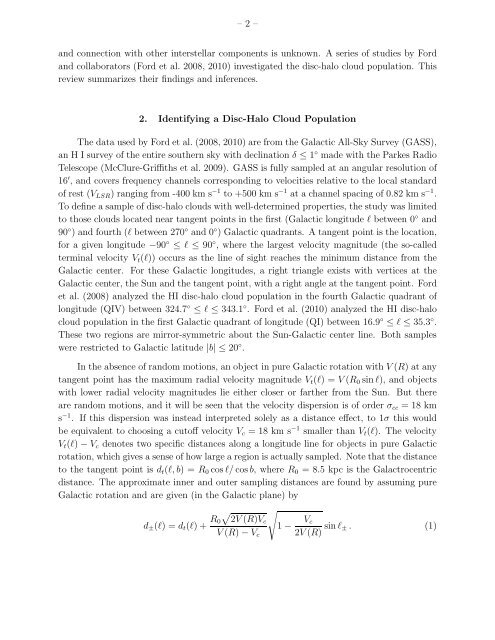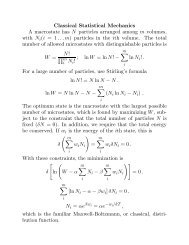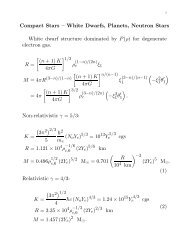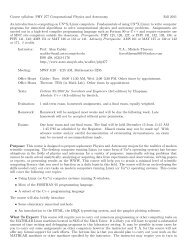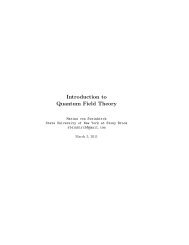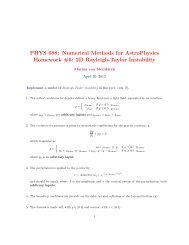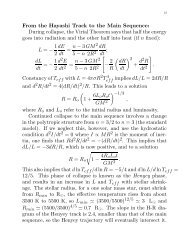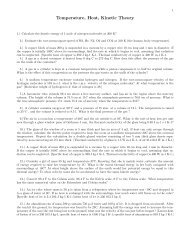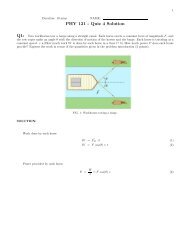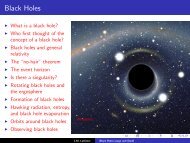sample research paper - Stony Brook Astronomy
sample research paper - Stony Brook Astronomy
sample research paper - Stony Brook Astronomy
You also want an ePaper? Increase the reach of your titles
YUMPU automatically turns print PDFs into web optimized ePapers that Google loves.
– 2 –<br />
and connection with other interstellar components is unknown. A series of studies by Ford<br />
and collaborators (Ford et al. 2008, 2010) investigated the disc-halo cloud population. This<br />
review summarizes their findings and inferences.<br />
2. Identifying a Disc-Halo Cloud Population<br />
The data used by Ford et al. (2008, 2010) are from the Galactic All-Sky Survey (GASS),<br />
an H I survey of the entire southern sky with declination δ ≤ 1 ◦ made with the Parkes Radio<br />
Telescope (McClure-Griffiths et al. 2009). GASS is fully <strong>sample</strong>d at an angular resolution of<br />
16 ′ , and covers frequency channels corresponding to velocities relative to the local standard<br />
of rest (V LSR ) ranging from -400 km s −1 to +500 km s −1 at a channel spacing of 0.82 km s −1 .<br />
To define a <strong>sample</strong> of disc-halo clouds with well-determined properties, the study was limited<br />
to those clouds located near tangent points in the first (Galactic longitude l between 0 ◦ and<br />
90 ◦ ) and fourth (l between 270 ◦ and 0 ◦ ) Galactic quadrants. A tangent point is the location,<br />
for a given longitude −90 ◦ ≤ l ≤ 90 ◦ , where the largest velocity magnitude (the so-called<br />
terminal velocity V t (l)) occurs as the line of sight reaches the minimum distance from the<br />
Galactic center. For these Galactic longitudes, a right triangle exists with vertices at the<br />
Galactic center, the Sun and the tangent point, with a right angle at the tangent point. Ford<br />
et al. (2008) analyzed the HI disc-halo cloud population in the fourth Galactic quadrant of<br />
longitude (QIV) between 324.7 ◦ ≤ l ≤ 343.1 ◦ . Ford et al. (2010) analyzed the HI disc-halo<br />
cloud population in the first Galactic quadrant of longitude (QI) between 16.9 ◦ ≤ l ≤ 35.3 ◦ .<br />
These two regions are mirror-symmetric about the Sun-Galactic center line. Both <strong>sample</strong>s<br />
were restricted to Galactic latitude |b| ≤ 20 ◦ .<br />
In the absence of random motions, an object in pure Galactic rotation with V (R) at any<br />
tangent point has the maximum radial velocity magnitude V t (l) = V (R 0 sin l), and objects<br />
with lower radial velocity magnitudes lie either closer or farther from the Sun. But there<br />
are random motions, and it will be seen that the velocity dispersion is of order σ cc = 18 km<br />
s −1 . If this dispersion was instead interpreted solely as a distance effect, to 1σ this would<br />
be equivalent to choosing a cutoff velocity V c = 18 km s −1 smaller than V t (l). The velocity<br />
V t (l) − V c denotes two specific distances along a longitude line for objects in pure Galactic<br />
rotation, which gives a sense of how large a region is actually <strong>sample</strong>d. Note that the distance<br />
to the tangent point is d t (l, b) = R 0 cosl/ cosb, where R 0 = 8.5 kpc is the Galactrocentric<br />
distance. The approximate inner and outer sampling distances are found by assuming pure<br />
Galactic rotation and are given (in the Galactic plane) by<br />
√<br />
d ± (l) = d t (l) + R √<br />
0 2V (R)Vc<br />
V (R) − V c<br />
1 − V c<br />
2V (R) sin l ± . (1)


